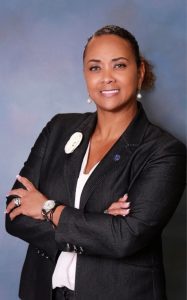When I reflect on my formal education – and my leadership journey to lead a community of learners as the superintendent despite statistical disparities and inequities I had to overcome – I cannot resist a strong a sense of gratitude and humbleness. Conversely, as I reflect upon the statistical data across the nation of those serving as superintendent, I cannot help but conjure up a disturbing thought and whisper to my inner self, “I am not supposed to be here.” Of the most apparent education leadership data points nationally, I am reminded each time I look in a mirror. I am a woman of color. Men hold the majority of superintendent positions across this nation and to be more specific, white males.
 What I have come to learn is that knowledge is not understanding and information is not experience. In an era of globalization and the demand for equitable access in education, those leading education have to bring the ability to understand and relate to diverse experiences that will help resolve some of the ongoing inequities that are perpetuated in our nation’s public schools. With inequities manifesting from a variety of familiar sources, such as: lack of access to quality teachers and leaders; misleading need for vouchers; controlled student voice; and limited student opportunities due to demographics, parental exclusion, cyber-bullying, increasing classroom size, missing access to technology, dwindling student motivation related to biases, inadequate facilities, confined budgets, and the rising levels of poverty in education are far more complex today than when I began teaching in 1994.
What I have come to learn is that knowledge is not understanding and information is not experience. In an era of globalization and the demand for equitable access in education, those leading education have to bring the ability to understand and relate to diverse experiences that will help resolve some of the ongoing inequities that are perpetuated in our nation’s public schools. With inequities manifesting from a variety of familiar sources, such as: lack of access to quality teachers and leaders; misleading need for vouchers; controlled student voice; and limited student opportunities due to demographics, parental exclusion, cyber-bullying, increasing classroom size, missing access to technology, dwindling student motivation related to biases, inadequate facilities, confined budgets, and the rising levels of poverty in education are far more complex today than when I began teaching in 1994.
Although the challenges are complex today, the one constant has been the dominance of males, in top education leadership positions, primarily as the superintendent. The 2018 American Association of School Administrators (AASA) data highlighted in an article, Where Are All The Women Superintendents?, indicates that of the 13,728 superintendent positions across the nation women hold only 1,984 (14 percent). Women in the education profession make up nearly 74 percent, but this number declines when it refers to leadership roles. Confirming the AASA data, other national education research associations do not limit the data to the superintendent position, but rather to all education leadership positions. The level of disproportionality (86 percent male) has created obvious inequities for women seeking opportunities in education leadership positions and likely contributes to many women leaders questioning their belonging or experiencing a feeling of being an imposter, alike.
If leadership is leadership, according to Cheryl Sandberg’s 2013 book, Lean-In: Women, Work, and the Will to Lead, and if we believe that leadership should not be gender or ethnically specific, then why the does the leadership gender gap exist? What will it take to increase the number of women or attract more diverse candidates of color serving in to an educational leadership position? These questions are not absent from the minds of many who lead in the education profession and are evident if you attend any national superintendent conference. After attending my first national conference as a superintendent, I began to ask myself that same question, and it became part of my dissertation topic on the female perception of the professional and political pathway to the superintendency in Virginia, which I successfully defended in 2014.
There are many theories, findings, doctoral dissertations, and books that have entertained the questions mentioned above, but there is no one final data point. In my analysis and throughout my professional experiences, I have formulated a number of those theories and can testify to some of the findings. Furthermore, the 2018 AASA research seems to align with my research findings and my professional education leadership experiences that women face challenges of breaking the glass ceiling, personal preference to be a teacher-leader, gender biases, positioned without the responsibilities of fiscal management, or seeking a superintendent position too late in their careers.
 No matter the position, or the cause – representation matters in all aspects of education. It is not a simple fix, but I believe the best way to attract more women and to create a diverse pool of candidates into education leadership positions is to “grow your own” in partnership with a local university or college through the development of an aspiring education leadership cohort. Beyond creating an aspiring leadership cohort, intentionally reviewing inequities in outdated hiring practices and policies; assigning an effective mentor or coach; providing some level of financial incentive; or leveraging the capacity of an aspiring leader would likely improve the appeal. However, I see the micro-politics and micro-aggressions that create undue burdens and lead to inequities as becoming more of an obstacle to closing the inequities no matter your gender or ethnic background. If we are to continue to be the profession that prepares ALL students for a future career or make them feel like they belong, then some, then, I would suggest that it is time not just to improve the profession, but rather, transform all levels of education and make them equitable from the classroom to the boardroom. This must be done through a deliberate investment in all aspects of education on behalf of our nation’s most precious resource – our students. Each student deserves a school that will prepare them for an opportunity to make a difference in the world that they will live in and to do this – WE must seriously consider ensuring that the education leaders know that they BELONG.
No matter the position, or the cause – representation matters in all aspects of education. It is not a simple fix, but I believe the best way to attract more women and to create a diverse pool of candidates into education leadership positions is to “grow your own” in partnership with a local university or college through the development of an aspiring education leadership cohort. Beyond creating an aspiring leadership cohort, intentionally reviewing inequities in outdated hiring practices and policies; assigning an effective mentor or coach; providing some level of financial incentive; or leveraging the capacity of an aspiring leader would likely improve the appeal. However, I see the micro-politics and micro-aggressions that create undue burdens and lead to inequities as becoming more of an obstacle to closing the inequities no matter your gender or ethnic background. If we are to continue to be the profession that prepares ALL students for a future career or make them feel like they belong, then some, then, I would suggest that it is time not just to improve the profession, but rather, transform all levels of education and make them equitable from the classroom to the boardroom. This must be done through a deliberate investment in all aspects of education on behalf of our nation’s most precious resource – our students. Each student deserves a school that will prepare them for an opportunity to make a difference in the world that they will live in and to do this – WE must seriously consider ensuring that the education leaders know that they BELONG.
Dr. A. Katrise Lee-Perera is a self-proclaimed life-long learner with nearly 25 years of service to learning communities and almost 19 in an education leadership capacity. She is an innovative and visionary public education leader in a progressively global and ever-changing learning environment. Her peers acknowledge her commitment, her dedication, her courageous leadership, and for being an equity warriorette. In 2015, the National Association of School Superintendents (NASS) named her the National Superintendent of the Year. Before being recruited and hired by the Gresham-Barlow School District (Oregon) in May of 2017, she served in a variety of school leadership positions in Virginia, Texas, and as an executive leader with McGraw-Hill Publishing Company.
